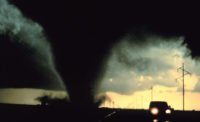Is your workplace ready for a natural disaster?

Hurricane/Tropical Storm Florence is a reminder that severe weather can wreak havoc on human, animal and environmental health and welfare.
OSHA is reminding employers and workers that September is National Preparedness Month – a good time to prepare for severe weather emergencies whether or not you live in a hurricane zone. Other parts of the country may experience tornadoes, extreme storms, flooding, wildfires and other acts of nature that threaten safety.
Loren Sweatt, Deputy Assistant Secretary for Occupational Safety and Health, said companies can keep workers safe by:
- Developing emergency plans and ensuring that workers know how to execute them. Plans should detail suitable places to take shelter, policies to ensure all personnel are accounted for, and procedures for addressing hazardous materials that are on-site.
- Staying aware and maintaining supplies: OSHA encourages everyone to stay aware of weather forecasts and keep emergency supplies, including a battery-operated weather radio, on hand to be prepared when severe weather strikes.
These general guidelines apply to all severe weather emergencies; however, preparation for specific hazards may vary by event. OSHA provides resources on workplace preparedness and response for specific severe weather emergencies, including tornadoes, hurricanes, floods, and wildfires. For more information on protecting workers from severe weather events, visit OSHA’s Emergency Preparedness and Response page.
An emergency plan
FEMA's Ready Business provides tools to create a plan that addresses the impact of many hazards:
Program Management
The preparedness program is built on a foundation of management leadership, commitment and financial support. Without management commitment and financial support, it will be difficult to build the program, maintain resources and keep the program up-to-date.
How much should be invested in a preparedness program depends upon many factors. Regulations establish minimum requirements and beyond these minimums each business needs to determine how much risk it can tolerate. Many risks cannot be insured, so a preparedness program may be the only means of managing those risks. Some risks can be reduced by investing in loss prevention programs, protection systems and equipment. An understanding of the likelihood and severity of risk and the costs to reduce risk is needed to make decisions.
Planning
The planning process should take an “all hazards” approach. There are many threats or hazards. The probability that a specific hazard will impact your business is hard to determine.
That’s why it’s important to consider threats and hazards and the likelihood they will occur.
Implementation
Implementation of the preparedness program includes identifying and assessing resources, writing plans, developing a system to manage incidents and training employees so they can execute plans.
Testing and Exercises
When you hear the word “testing,” you probably think about a pass/fail evaluation. You may find that there are parts of your preparedness program that will not work in practice.
Post-incident critiques often confirm that experience gained during exercises was the best way to prepare teams to respond effectively to an emergency. Exercises should be designed to engage team members and get them working together to manage the response to a hypothetical incident. Exercises enhance knowledge of plans, allow members to improve their own performance and identify opportunities to improve capabilities to respond to real events.
Program Improvement
There are opportunities for program improvement following an actual incident. A critique should be conducted to assess the response to the incident. Lessons learned from incidents that occur within the community, within the business’ industry or nationally can identify needs for preparedness program changes. Best practices and instructional guidance published by trade associations, professional societies, newsletters and government website can be resources to evaluate and improve your preparedness program.
Business Continuity Planning Suite
If you need more help getting a business or organization prepared, please use the new Business Continuity Planning Suite (ZIP Archive - 13 Mb: PC Compatible) developed by DHS’ National Protection and Programs Directorate and FEMA.
For more detailed information, visit //www.ready.gov/business.
If you or a loved one live in an affected area, please visit the National Oceanic and Atmospheric Administration’s National Weather Service for more information.
You may also like:
Staying safe amid Florence's hazards

Electrical safety during hurricane season
Looking for a reprint of this article?
From high-res PDFs to custom plaques, order your copy today!







